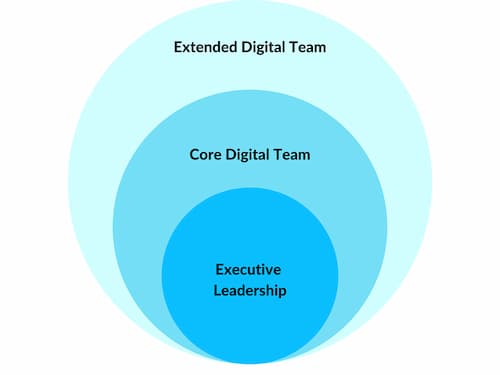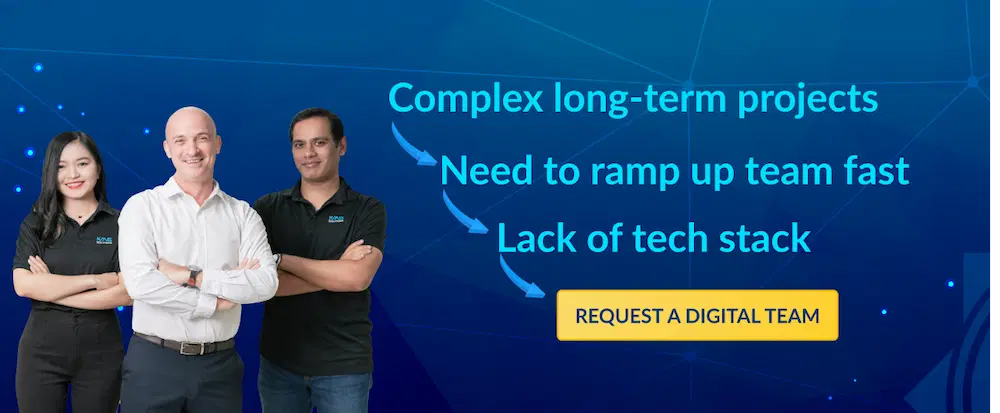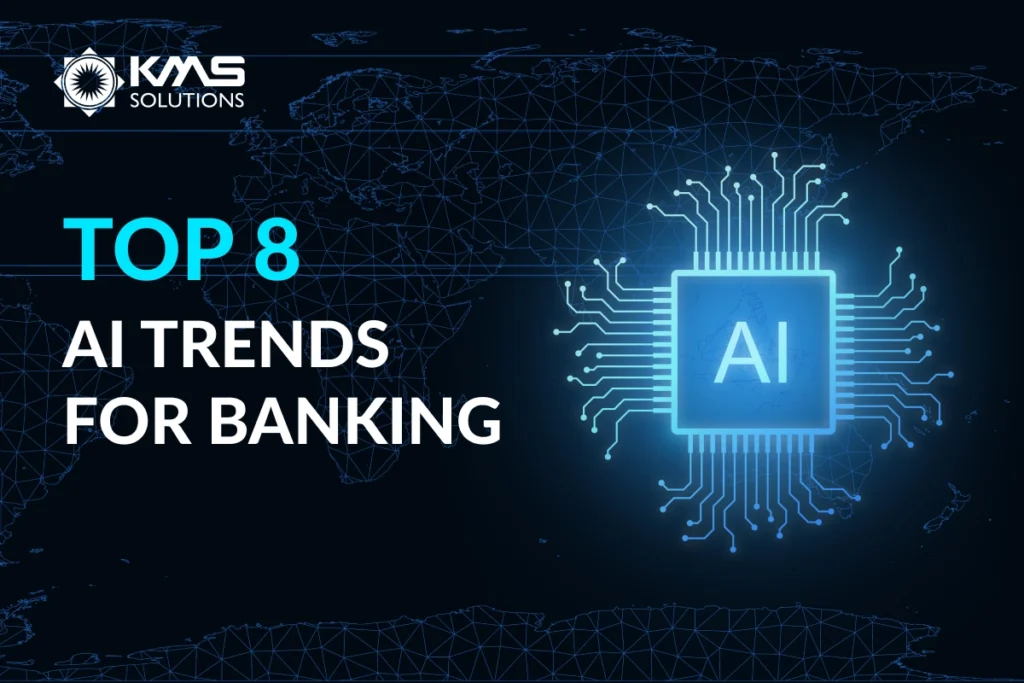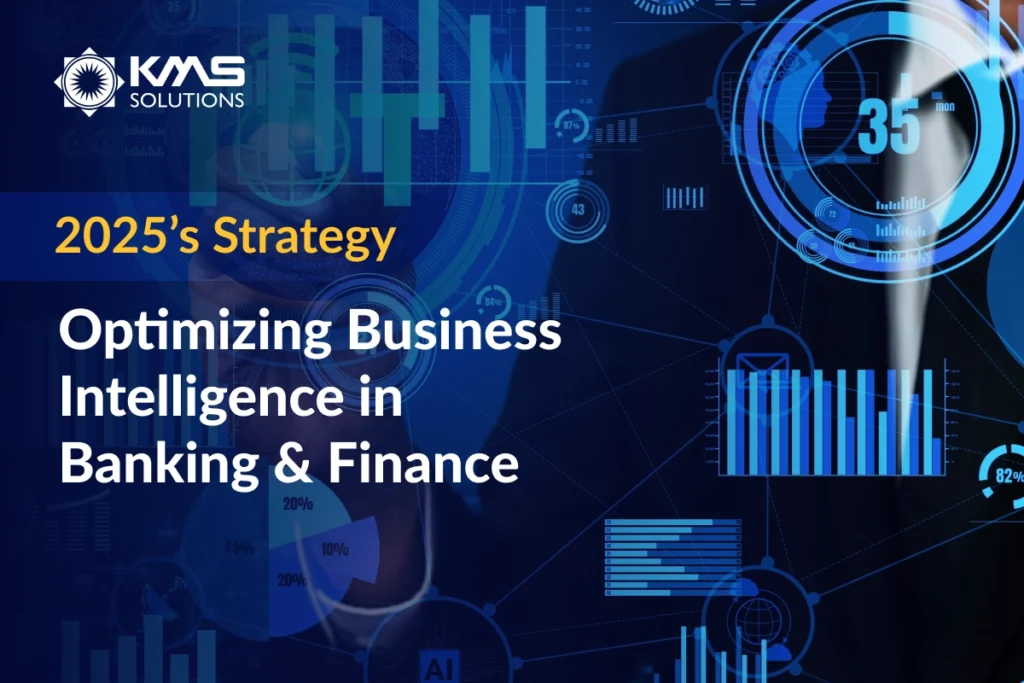Innovative technologies are the building blocks of a Digital Transformation. That’s for sure. But for these technological blocks to be planned out and put together, you need a Digital Team—a group of people who lays the foundation for your Digital Transformation.
This is why, times and again, businesses are reported to consider “people” as the most influential factor in their Digital Journey—not technologies per se.
Thus, assembling the Digital Team should be the top box in your digitization checklist.
What is a Digital Team?
A digital team is a group of cross-functional individuals who can fully own your tech projects or supplement your in-house IT team. The digital team can fill any position you lack in the development team, from the C-level executives who set the project vision, the project manager who facilitates the processes to solution architects who turn ideas into functional code and designers who augment user experience.
All members work in high synergy towards a single goal: making Digital Transformation happen.
A few aspects of the Digital Team you need to take into account:
- People: a leader must be needed to lubricate and motivate the project. Cross-functionality, as was discussed, and synergy are the pillars of a Digital Team.
- Technology: not everything needs replacement, only the bottlenecks. Old technologies can be modernized or exposed to APIs for advanced integration.
- Information: Data must be streamlined across the team and be turned into insights to support decision-making.
- Process: critical stakeholders in the Digital Team should identify the most impactful processes and make appropriate updates. The goal is to achieve more efficient strategies.
What does a Digital Team look like?
Now we have the definition of a Digital Team. But still, it’s quite abstract. Let’s now discuss what a Digital Team looks like. If a Digital Team is a framework, there will be three layers: Executive Leadership, Core Digital Team, and Extended Transformation Team.

Executive Leadership
Digital Transformation requires support and advocacy from top management. It’s the C-levels and top managers who have the big picture of the business. In other words, they understand the company more than anyone else. Thus, no one other than these leaders can articulate the mission of the Digital Team and build consensus across the organization.
As they are held responsible for leading the Digital Team, some prime candidates for this layer include Chief Digital Transformation Officer (CDTO), Chief Digital Officer (CDO), Chief Technology Officer (CTO), or Chief Information Officer (CIO).
Digital Transformation is usually taken for granted as CDTO or CDO’s job. However, this misconception should be dispelled. Digital Transformation requires the collaboration of the entire C-Suite or all efforts could result in superficial changes in operations and culture.
If you lack the roles needed, another way is to hire an external senior consultant who has the appropriate expertise and experience.
Skills required of the executive leadership:
A deep understanding of the business is an essential requirement for these leaders of Digital Transformation. As they know the business thoroughly, they understand which areas to focus on.
The second requirement is general knowledge of modern technologies, including Cloud, Artificial Intelligence, and Data Analytics. These skills help them leverage the right talents for the Digital Team.
The last but most important skill is people management. In the Digital Team, executive leaders must have the ability to get buy-in from the board members, influence people, drive cultural shifts, and get the entire organization on board with Digital Transformation.
Core Digital Team
This layer comprises practitioners who are well-versed in various technologies and business verticals. When considering talents for your Core Digital Team, you should turn to Product Managers, Program Managers, Solution Architects, and Industry Consultants.
When it comes to this layer, most businesses would find themselves lacking one or a few designations. Therefore, hiring new professionals or reskilling current employees is always necessary at this stage.
In addition, employees must be given opportunities to get used to new initiatives and even change their career paths. Businesses would need to organize extensive training programs and workshops depending on the technologies and skills required.
Skills required of the Core Digital Team:
Depending on the tools and technologies that will be applied within the scope of your Digital Transformation, the skill requirements can vary from project to project.
An example may help. If your company plans to migrate to the cloud, you will need experts with expertise in cloud technologies such as Microservices, Containers, or Serverless architecture. Based on these technologies, you will need to engage cloud architects, cloud engineers, data center operations, … Or if you ever want to get into Artificial Intelligence (AI), Machine Learning specialists, Data Scientists, Data Engineers are the prime candidate for your Digital Team.
Not every organization has these roles in place, so reaching out to an external digital team partner can be a long-term solution.
Extended Digital Team
As an extension to your core team, this add-on team can involve developers, designers, visualizers, AI/ML engineers, business intelligence analysts, etc.
Skills required of the extended Digital Team
Software development, designing, and data science are some areas of expertise you need to consider for your extended digital team. Depending on the size of your business and the scope of your Digital Transformation, an extended digital team can be huge.
Usually, it would require businesses to reskill their existing employees or hire more specialists with experience with the necessary technologies. Again, digital team service is on the rise. Providers of this service have a large pool of talents with expertise in diverse technologies, where you can easily make up for the experts you need to get your Digital Transformation up and running.
Key elements behind a digital team structure
People are the pillar of every product. How well you map your business goals to the roles in a software development team plays a huge role in determining your project’s success. Thus, when establishing a digital team structure, make sure you consider these factors:
1. Project type and complexity
The first and foremost thing when building a digital team is to work out the scope of your project. If you aim to create a product prototype, a group of four individuals could suffice to complete the work. Conversely, if you intend to roll out a new application that involves sophisticated features and third-party integrations, the number of team members will likely need to be expanded. Following are some examples of how a project’s scope and a software development team structure can be interrelated.
Project scope/stage | Team size | Team roles |
| Discovery/Proof of concept | Approximately 5 specialists | Product owner, project manager, business analyst, software architect, UI/UX designer |
| MVP Development | More than 6 members | Product owner, project manager, business analyst, UI/UX designer, software developers, testers |
| App Development | Waterfall: no team size limit; the specific headcount will depend on the product complication. Agile: usually around 9 specialists; for large-scale projects, several Agile teams might be assembled and collaborated | Product owner, project manager, business analyst, UI/UX designer, software developers, testers Optional: DevOps engineers, security engineers, automated testers. |
2. The duration available to accomplish the project
The speed at which you want to deliver your product will also impact the size and structure of your digital team. A smaller team might take more time to finish the project. Hence, if you have a vision for a cutting-edge solution that must be created from scratch and within a short timeframe, you might need to put together a large team of experienced developers or a group of full-stack engineers who can meet all requirements and deliver the outcome promptly and productively.
3. The budget set out for development
Closely linked to all the above-mentioned factors, the available budget would undoubtedly impact every choice you make, such as the number and expertise of team members you can recruit, as well as the extent of features in the final product. To lower project costs while maintaining quality during the initial stages of development, consider implementing one of the Agile project management approaches. You can have greater financial flexibility by delivering in increments and prioritizing critical features first.
4. Software development methodologies
Your choice between Waterfall and Agile would directly influence the workflows and structure of your digital team. Whatever project management methodology you select determines the team’s size, the task assigned to members, and the dynamics within the team. Let’s review some key facts about these two approaches and examine how their unique characteristics are mirrored in the software development team structure.
Waterfall | Agile | |
| Software development process | The development process is commenced in a series of sequential phases | The development process is divided into shorter sprints that typically last 2-4 weeks |
| Project scope | The project scope is predetermined, and changes to it are usually limited | Allows for scope changes during development |
| Client involvement | Mainly required at specific milestones for deliverable acceptance | Client’s participation throughout the development process |
| Feature prioritization | Features are prioritized at the start of the project based on Work Breakdown Structure (WBS) | Features are prioritized at the beginning of each sprint, and issues are handled based on their priority. |
| Focus and mindset | Project mindset which focuses on completing the project | Product mindset which concentrates on delivering value to the customer |
| Quality assurance | Software testing is performed after the development phase | Testing is done simultaneously with the development stage |
| Pricing model | Lower risk with Fixed Price | Works well with Time & Material |
In what way do these distinctions impact the digital team composition?
The structure of a Waterfall project team is determined by hierarchical relationships between team members, with managers and subordinates having clearly defined roles. This team structure gives the project manager greater control over project workflows and decision-making authority. Due to larger team size and a vertical hierarchy, the model typically has a lower degree of team synchronization.
In contrast, Agile teams are self-organized and self-managed. Still, there are organizational leaders such as a Scrum Master in Scrum or a Service Delivery Manager in Kanban. Unlike the traditional Waterfall model, these leaders are primarily responsible for fostering relationships within the team and creating a working environment that enables each team member to be productive. Agile teams are generally smaller, with a maximum of 9 to 10 people. They offer a degree of autonomy that allows team members to prioritize their workloads and shape their workflows to suit their preferences.
Where to find a digital team?
Forming an in-house development team can be time-consuming and resource-intensive. And it might not make sense when you only need them for a one-off project. Hence, an outsourced software development team becomes an ideal solution for many businesses whose core competencies are not relevant to technology. The cost-effective approach allows companies to increase their flexibility and access a wider range of specialized skills without having to invest in new infrastructure or hire additional employees.
Hence, recruiting a digital team is, without a doubt, exceptionally advantageous for enterprises, but how do you locate the right digital team? This won’t be an issue if you know where to start looking.
Digital Publications
Outsourced developers aren’t only skilled at building apps, they’re also incredibly generous in sharing software development tried-and-true practices. When searching for IT know-how for your tech projects, you might come across blog posts or industry insights written by them. Usually, those articles will be published via their websites or popular platforms such as Medium and LinkedIn.
Reading through such materials can help you gauge their technical expertise and other factors impacting collaboration between them and your internal teams. For instance, you can estimate their language proficiency by assessing how ideas are interpreted in the article.
Review Platforms
It’s essential to conduct proper research before employing a digital team. A highly recommended method is to evaluate the team’s performance based on feedback from their previous clients. Instead of directly contacting these clients, you can rely on review platforms such as Clutch and GoodFirms to provide comprehensive information about the team’s services, including ratings, testimonials, hourly rates, and their services.
If you want to learn more about Digital Team and how it can help initiate and accelerate your Digital Transformation, leave your information here:











